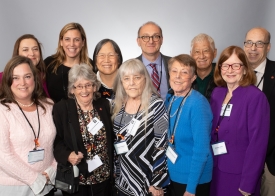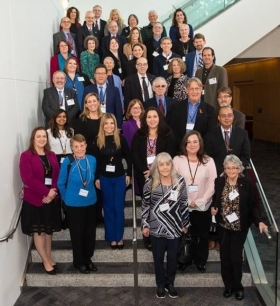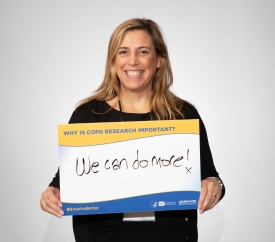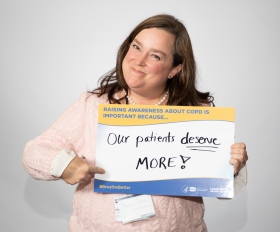The COPD National Action Plan: Where are we now and where are we headed?
Posted on December 16, 2019 |

The COPD National Action Plan, released in 2017, is a guide to how we can improve COPD outcomes in the United States. On November 13th, the community came together to share the progress that has been made against the Plan’s goals and to discuss how we collaborate and track progress moving into the next decade.
The COPD Foundation team was joined by five advocates who ensured the perspectives of those most affected by COPD were heard throughout the discussions. The day was broken into two parts, a morning session full of informative presentations from federal partners, advocacy organizations and health systems, and afternoon discussion sessions to brainstorm on how to effectively collaborate and track progress moving forward.
The day started with Dr. Tony Punturieri from the National Heart, Lung and Blood Institute’s (NHLBI) overview of their priorities and areas of progress such as the groundbreaking results coming from the COPDGene Study. Dr. Punturieri also discussed progress in understanding the role of smoking in COPD development, in dispelling the notion that COPD treatment is a one-size-fits-all approach, and in pushing early-stage disease-modifying research. He noted that they feel “the future and the present for COPD is bright.”
The next panel of speakers from federal agencies highlighted the progress made possible by the National Action Plan and your advocacy efforts. The Centers for Disease Control and Prevention (CDC) presented new data on the burden of COPD and how they are using the Behavioral Risk Factor Surveillance System (BRFSS) data to understand factors that may be associated with COPD outcomes in different areas of the country.

We dedicated much of the first years of our advocacy efforts to getting COPD questions on the BRFSS. Hundreds of patients contacted their state officials to make this happen. The results have yielded treasure troves of data about the burden of COPD in different geographic areas, but that isn’t all it can do. As more attention is focused on COPD in the public health space, the BRFSS COPD questions can now be layered with other data that show patterns of smoking history, comorbid diseases, and other health risk factors. The more we make COPD a part of the conversation in other health priority areas, the greater likelihood it lands on the radar of state and federal agency partners and the greater likelihood we can reach affected individuals.
The federal partner panel also included speakers from the Veterans Affairs who talked about their areas of focus, including a growing interest in home-based pulmonary rehab services. A representative from CDC’s National Institute for Occupational Safety and Health spoke about their working group to address workplace exposures, including a series of videos featuring stories from patients who are affected by COPD in the workplace.
Finally, Paul Moore from the Office of Rural Health Policy (ORHP) in the Health Resources and Services Administration (HRSA), gave an overview of his offices’ extensive activities since the Plan’s release, including recommendations on how to improve COPD outcomes in rural areas and supporting collaborations that produced new resources for healthcare systems. ORHP has embraced COPD as part of their agency’s mission and is an example of how COPD fits into a federal agency’s existing work even without new laws or funding.
The remainder of the morning featured national and regional initiatives, including our own COPD Foundation presentation covering how our initiatives map to the Plan’s goals. Throughout the two panels it was clear there is great work happening in the COPD community from a growing, but still, limited, group of stakeholders who feel passionate about improving COPD outcomes. Their motivations for involvement may be different, from financial pressure to improve readmission rates as in the case of Dr. Anil Singh from Allegheny General, Respiratory Health Association's desire to support caregivers via their Caregiver Toolkit, and Atrium Health’s quest to master the art of social media to grow COPD awareness, but their commitment is leading to meaningful improvements.

After lunch, the topic of conversation turned “what now.” Goal 5 of the Plan suggests the creation of a formal coordinating mechanism. The NHLBI proposed a draft tool that can be used to capture and map community initiatives that achieve one or more of the Plan’s goals. The web-based tool would capture a description of the program or tool, the goals of the Plan it maps too, the people involved, the type of resources available to others, press or scientific articles, lessons learned and more. Attendees broke into groups and completed example entries for an existing initiative, then discussed how we could improve and use a tool like the proposed to power greater resource sharing and track progress against the Plan’s goals.
By the end of the afternoon, a few things were clear. First, the NHLBI is committed to its leadership role in COPD and they want to ensure we don’t let the National Action Plan sit on the shelf. Second, the Plan has already led to some notable successes. We often feel that we are “preaching to the choir” about the importance of COPD issues, but even when that is the case, the choir has grown in the years since the Plan’s release. More federal partners are including COPD messages in their outreach, agencies like HRSA have adopted COPD as a priority and health systems and insurers are coming to the table slowly but surely to figure out how to improve COPD outcomes.

We still lack federal resources to power widescale change and the adoption of COPD as a public health priority, and there are areas within the Plan that haven’t begun to be addressed. With your voices, the commitment of the NHLBI and the dedicated partners already in the COPD space we will continue to march forward towards a world where COPD is diagnosed early and accurately, patients feel empowered and healthcare professionals, health systems and payers collaborate to deliver evidence-based, high quality, patient-centered care that, together with robust research efforts and policy change, leads to a lower burden of disease. We hope that through improved coordination of Plan implementation and a growing chorus of advocates, including your voices, we can go beyond that incremental change and reach a tipping point where COPD becomes a national health priority and a normal part of our health conversations.
You can watch the recording of the morning sessions and read more about the event in NHLBI’s recap. Gain additional insight into the discussions with a and two scientific perspectives on our PRAXIS Blog. We hope you will join us in thinking about how we can better implement the COPD National Action Plan as we enter 2020 and we look forward to hearing from you about the progress you see in your community, in your lives and what you want to see happen in 2020!